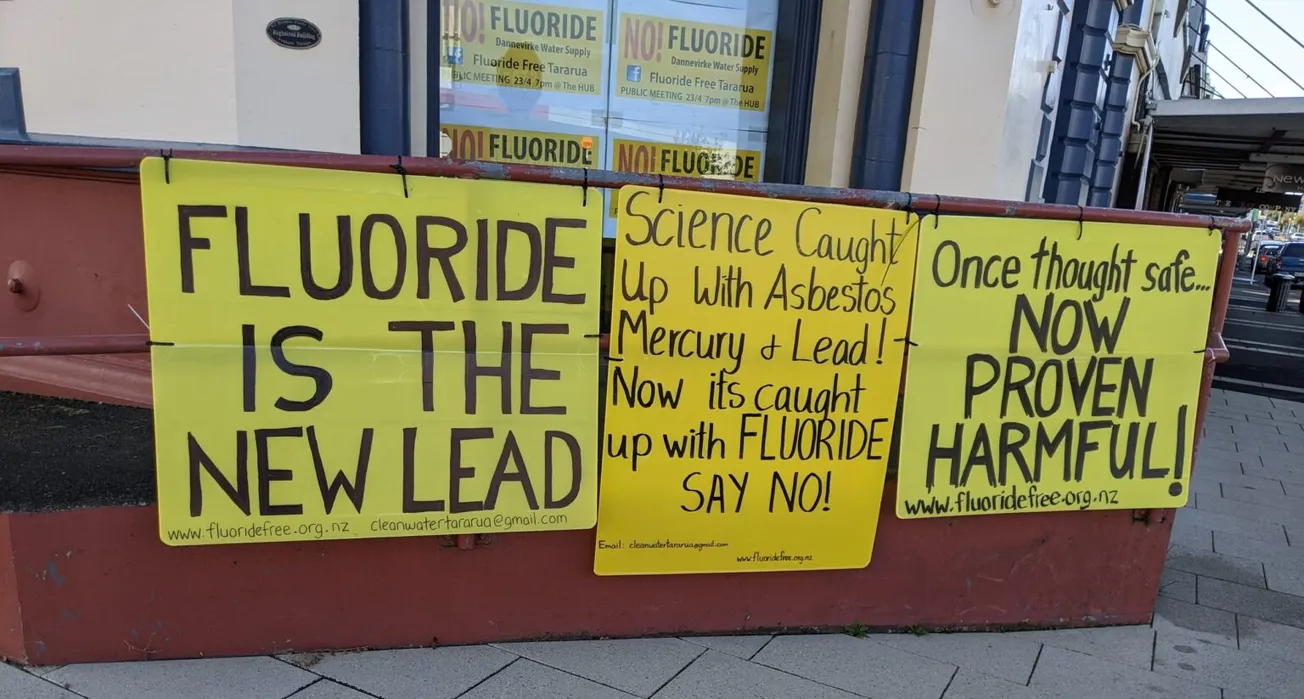Table of Contents
Understanding the Issue
Brushing teeth and using tap water are daily routines. But did you know that the very authorities responsible for fluoridating our water wear hazmat suits to handle the chemicals? If fluoride can’t be safely disposed of in natural waterways, why is it added to our tap water?
This month, we’re spotlighting Fluoride-Free July, an initiative aimed at educating New Zealanders about the harmful effects of fluoride in our drinking water. Our friends at Fluoride Free New Zealand (FFNZ) are leading this charge, revealing the shocking truth about this toxic waste being unlawfully introduced into our water and environment.
Also see:
- “Just Following Orders” – and The Fluoride Fraud
- The Fluoride Scandal
- Water Fluoridation Part 1: Understanding the Fluoride Controversy
- Does The NZ Bill of Rights Matter?
Watch the Controversial Ad
In 2016, FFNZ released a 30-second TV ad highlighting the dangers of fluoride. Despite multiple complaints, the Advertising Standards Authority (ASA) found the ad truthful and accurate, allowing it to continue airing. This was a significant victory for transparency and public health awareness.
You can watch the ad below:
Transcript:
“Hydrofluorosilicic acid, commonly known as fluoride, is a waste product collected from the chimneys of the fertiliser industry. This fluoride chemical also contains traces of lead, aluminum, mercury, arsenic, and sometimes uranium. It is banned from being released into the air, sea, lakes, and rivers because it is toxic to animals and the environment. Instead, ratepayers’ money buys this toxic chemical, handled by workers wearing hazmat suits. This fluoride is what goes into our drinking water.”
ASA Decision on Fluoride Ad
The ASA’s decision on FFNZ’s 2016 TV ad further supports the factual basis of the claims made about fluoride. The ASA reviewed the ad under complaint number 16/297. The complainants argued that the ad was misleading. However, the ASA did not uphold the complaints, confirming that the information presented was accurate and not deceptive.
The Dangers of Fluoridation
The ad outlines that the chemical byproduct added to our drinking water is too hazardous for disposal in forests, land, seas, and lakes due to its detrimental effects on plants, animals, and the environment. While most of the world has abandoned fluoridation, our local councils continue to purchase and add this hazardous waste to our drinking water.
Where is the logic in this approach? If fluoride is too dangerous for our flora and fauna, how can it be considered safe or beneficial for humans, including our children? It has been strongly linked to brain damage and other health issues. The introduction of this substance into our water supply lacks proper consent and has not passed a Bill of Rights Assessment, making it a coerced form of medical treatment.
Taking Action
To combat this issue, we need to place continuous pressure on the Director-General of Health to conduct the court-mandated Bill of Rights Assessment. Here’s how you can help:
- Write to Your Representatives: Send letters to your local council, MP, or directly to New Zealand’s Director-General of Health, Dr Diana Sarfati (diana.safarti@health.govt.nz), demanding a justification for the continued fluoridation of our water. Ask why this toxic action is being carried out under the guise of ‘medicating’ us without our consent. [Please click on this link to go through to the original NZDSOS article, where emails to individual NZ MPs are provided. Ed.]
- Use Letter Templates and Question Examples: If you’re unsure what to say, check out this post and see the questions below for examples. Tailor these letters to express your concerns about toxins, child brain health, and the lack of evidence supporting fluoride’s benefits for teeth.
Potential Questions You Could Ask Your MP, local council or NEW Zealand’s Director-General of Health
- Please can you advise what information the Ministry of Health is providing to pregnant women and mothers of bottlefed babies about the potential risks of consuming fluoride. I understand there are risks to the developing brain from consuming fluoridated water.
- I’ve heard iodine is important for the glands in the female breast and the thyroid gland. If I am consuming water with fluoride and chlorine, what does that do to my iodine levels? Should I monitor my thyroid function and how often should I get a blood test?
- Is the Regional Council planning to do any monitoring of the effects of fluoridated water being allowed into our environment?
- Can you provide an update on how the Director-General is progressing with the Bill Of Rights Act assessment regarding water fluoridation for Oamaru (or Dannevirke, Rotorua, Whangarei, Hastings etc). When will the report be provided?
- Is it true that the fluoridation chemicals put in NZ’s drinking water are a waste product of the fertiliser industry? What contaminants may be present and who assesses this? Where do the public see the results of any assessment?
- Wouldn’t it be cheaper to get kids to brush their teeth and not drink fizzy drinks than to make councils put fluoride in the water supply?
- How do I know that the levels of fluoride in my water are being carefully monitored and where do I see the results of regular testing?
- How much does the Council spend on fluoridation chemicals and equipment maintenance each year?
- If fluoride causes visible fluorosis on teeth, does that mean the same thing is happening to bones but it just can’t be seen?
- Can the council please provide community drinking water fountains with fluoride (and chlorine) free water?
- Do people with kidney problems or kidney transplants need to be careful to avoid fluoridated water?
Stay Informed and Connected
Stay updated with daily information from Fluoride Free New Zealand by following them on Facebook and and bookmark FluorideFree.org.nz. Their updates may be eye-opening, especially if you haven’t been fully aware of fluoride’s effects and dangers before.
By joining forces and making our voices heard, we can push for a fluoride-free New Zealand and protect our health and environment.
Let’s take action now.
This article was originally published by New Zealand Doctors Speaking Out with Science.









